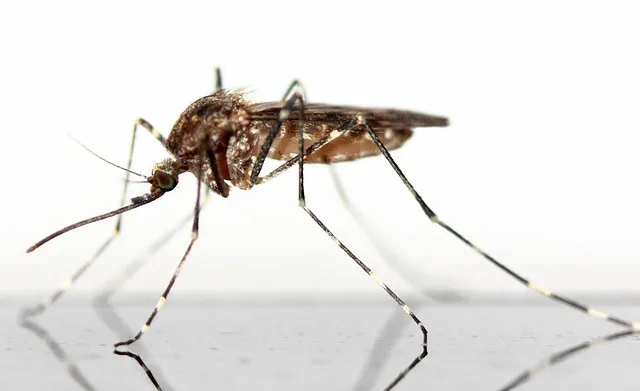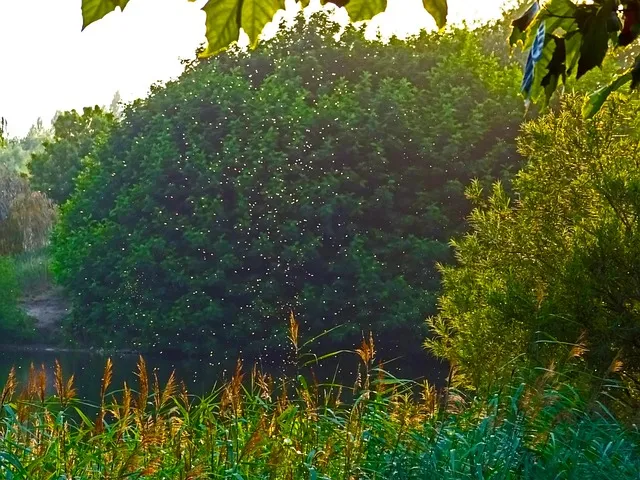Mosquito Control: A Comprehensive Approach
Mosquito control involves understanding their behavior, breeding in stagnant water, and attraction to carbon dioxide and body chemicals. Effective strategies include eliminating standing water, using natural predators or bacteria for larvae, maintaining water flow, and employing repellents like citronella or DEET. Physical barriers like screens and netting are also crucial. Community efforts, environmental management, and innovative technologies further enhance mosquito control, ensuring safer outdoor experiences.
Mosquitoes are more than just a nuisance; they pose significant health risks, transmitting diseases like malaria, dengue, and Zika. Understanding these insects’ behavior and habitat is crucial for effective mosquito control. This article guides you through a comprehensive approach to protect against mosquitoes, covering natural and chemical repellents, physical barriers, environmental management, and innovative technologies. By implementing these strategies, you can significantly reduce mosquito-borne risks and create healthier living environments.
Understanding Mosquitoes: Behavior and Habitat

Mosquitoes are more than just a nuisance; they’re tiny pests with a complex life cycle and specific habitat preferences. Understanding their behavior is key to effective mosquito control. These insects go through four developmental stages: egg, larva, pupa, and adult. They lay eggs in stagnant water, which can be as small as a puddle or as vast as a lake. The larvae that emerge feed on organic matter in the water, while adults are flying feeders, primarily attracted to carbon dioxide, heat, and specific chemicals released by our bodies. Knowing this behavior allows us to implement targeted strategies for protection.
Controlling mosquito populations requires a multi-faceted approach. Eliminating standing water where they breed is a first step in mosquito control. Regularly emptying containers like flower pots, buckets, or old tires can significantly reduce breeding grounds. For larger bodies of water, maintaining water flow and introducing natural predators like fish or bacteria that target larvae can be effective. These measures disrupt their habitat and life cycle, leading to reduced mosquito populations and providing better protection for outdoor activities.
Identifying Common Mosquito Breeding Sites

Mosquitoes breed in standing water, so identifying and eliminating these sites is a key part of mosquito control. Common areas where mosquitoes thrive include clogged gutters, buckets, flower pots, old tires, birdbaths, and any container that can hold water. Even small amounts of stagnant water can provide the perfect breeding ground for these pests. Regularly checking and emptying such items around your home or property can significantly reduce mosquito populations.
Additionally, maintaining a tidy outdoor space by trimming vegetation, raking leaves, and removing potential hiding spots like dense bushes or tall grass can further deter mosquitoes from making your area their breeding ground. These simple steps are an effective way to take control of mosquito prevention in your immediate surroundings.
Natural Repellents and Their Effectiveness

Natural repellents have long been a popular and eco-friendly approach to mosquito control, offering an alternative to chemical-based solutions. Essential oils like citronella, lavender, and peppermint are well-known for their ability to ward off mosquitoes. These natural compounds can be found in various forms, such as candles, diffusers, or topical applications, providing a pleasant aroma that keeps the bugs at bay. Scientific studies have backed up these claims, showing that certain scents can effectively repel mosquitoes, with some even surpassing the performance of DEET, a commonly used chemical repellent.
The effectiveness of natural repellents lies in their ability to mask human odours and body heat, which attract mosquitoes. By introducing these aromatic substances into the environment, they create a protective barrier, making it less appealing for mosquitoes to land and feed on humans. While natural methods may require more consistent application than chemical products, they are generally considered safer and more environmentally friendly, making them a preferred choice for those seeking holistic mosquito control solutions.
Chemical Repellents: Active Ingredients and Safety

Chemical repellents are a common method for mosquito control, using active ingredients that can effectively ward off these pests. DEET (N,N-diethyl-m-toluamide), often found in popular brands, is renowned for its potency. However, it’s important to note that while DEET is generally safe when used as directed, it may cause skin irritation for some individuals and has raised concerns about potential neurotoxic effects, especially with prolonged or excessive use.
Other active ingredients like picaridin, IR3535, and oil of lemon eucalyptus offer alternatives with fewer side effects. These substances mimic natural compounds that mosquitoes find unpleasant, thereby repelling them. The safety of these chemicals is well-studied, making them viable options for families and outdoor enthusiasts seeking mosquito control without the potential drawbacks associated with DEET.
Physical Barriers for Mosquito Control

Physical barriers are an effective and environmentally friendly way to control mosquitoes, acting as a line of defense against these persistent pests. Simple yet powerful, these barriers include screens and nets designed to keep mosquitoes out while allowing fresh air to circulate. They are particularly useful in indoor spaces, providing a safe and comfortable environment free from mosquito bites.
For outdoor areas, physical barriers like mosquito-proof screens on windows and doors, as well as netting over patios or garden seating, can significantly reduce mosquito presence. These structures act as a protective layer, blocking mosquitoes’ access to humans and reducing the risk of diseases they may transmit. By combining physical barriers with other mosquito control methods, individuals and communities can achieve a more comprehensive approach to mosquito management.
Environmental Management Strategies

Effective Mosquito Prevention and Protection goes beyond personal measures; Environmental Management Strategies play a pivotal role in Mosquito Control. This involves altering habitats to reduce breeding grounds, as mosquitoes primarily breed in stagnant water. Implementing regular water management practices, such as draining standing water from containers, buckets, and flower pots, can significantly curb mosquito populations. Additionally, maintaining proper landscaping with regular weeding and trimming helps prevent the accumulation of damp, shady areas that mosquitoes favor.
Community-wide initiatives, including collaborative efforts to clean up and maintain local environments, further enhance Mosquito Control. Educating residents on the importance of these strategies fosters a collective responsibility for creating a healthier, less hospitable environment for mosquitoes. By integrating these environmental management tactics into our daily routines, we can substantially reduce mosquito presence, leading to a more comfortable and safe living space.
Personal Protection Measures When Outdoors

When spending time outdoors, taking personal protection measures against mosquitoes is essential for effective mosquito control. One of the most effective barriers is applying insect repellent containing DEET or picaridin on exposed skin. These chemicals create a protective layer that deters mosquitoes from biting. Wearing long-sleeved clothing and pants, especially during dawn and dusk when mosquitoes are most active, can also significantly reduce bite risks.
Additionally, using mosquito nets while sleeping outdoors or in areas with high mosquito activity provides robust protection against bites. The mesh fabric prevents mosquitoes from reaching your skin, offering a peaceful night’s rest. Proper disposal of standing water around homes is another crucial step in mosquito control, as these sites serve as breeding grounds for the insects. Regular cleaning of gutters and removing items that collect water can significantly reduce local mosquito populations.
Preventive Actions for Households and Communities

Mosquito prevention isn’t just about personal protection; it’s a collective effort for households and communities to safeguard their living spaces. Key actions include eliminating standing water, where mosquitoes breed, as even small amounts can serve as breeding grounds. Regularly cleaning items like gutters, flower pots, and birdbaths is essential. Communities can collaborate by implementing larger-scale mosquito control programs that involve treating bodies of water with larvicides or using mosquito traps to reduce adult populations.
Additionally, installing screens on windows and doors helps keep mosquitoes out while allowing fresh air circulation. Using insect repellents containing DEET when outdoors is effective, but also consider planting mosquito-repelling plants like citronella, lavender, and marigolds around your home. These natural methods complement conventional mosquito control practices, contributing to a healthier, less pestilent environment for everyone.
Innovative Technologies in Mosquito Management

In the realm of mosquito prevention and protection, innovative technologies are revolutionizing mosquito control. From advanced trapping systems that use light and carbon dioxide to attract and capture mosquitoes, to smart sensors that can predict and detect mosquito activity in real-time, these tools offer more effective and eco-friendly solutions compared to traditional methods like spraying pesticides.
Additionally, genetic engineering and biological controls are emerging as powerful allies in the fight against mosquitoes. Scientists are developing genetically modified mosquitoes that reduce populations by interfering with their reproductive cycles. Similarly, introducing natural predators such as fish and birds can help manage mosquito habitats. These cutting-edge approaches not only enhance mosquito control but also contribute to a more sustainable and holistic approach to protecting communities from these pests.
